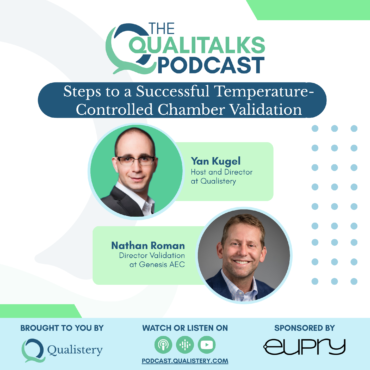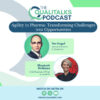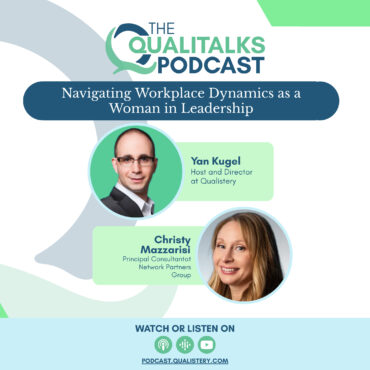
Steps to Validating a Temperature Controlled Chamber [Nathan Roman]
In this episode, Nathan Roman shares his knowledge of the different steps and regulations when validating a temperature-controlled chamber.
 play_arrow
play_arrow
Agility in Pharma: Transforming Challenges into Opportunities [Elizabeth Hickman] Elizabeth Hickman
 play_arrow
play_arrow
Navigating Workplace Dynamics as a Woman in Leadership [Christy Mazzarisi] Christy Mazzarisi
Nathan Roman March 23, 2023 297

Table of Contents
In the latest episode of Qualitalks, Yan Kugel and Nathan Roman dive deep into the world of qualification protocols and share their insights on writing effective ones.
Nathan explains that a qualification protocol is a written plan describing the qualification process and how the qualification will be conducted. He emphasizes the importance of understanding the project and its requirements and suggests using templates or a basic protocol format to ensure consistency in documentation preparation.
In addition, Nathan discusses the evolution of qualification protocols, including the incorporation of paperless validation and the need to stay up-to-date with new technologies.
-What is a qualification protocol?
-When should you have it ready?
-What are the prerequisites?
-What should it include?
-And what are some common problems?
Make sure you don’t skip this enlightening and captivating dialogue. Listen in immediately!
This episode is sponsored by Eupry, a leading provider of comprehensive environmental monitoring and validation solutions for regulated industries. With a focus on temperature, CO2, humidity, and differential pressure, Eupry helps companies ensure compliance with industry standards and regulations. All that while providing reliable and accurate data to support informed decision-making.
Learn More About Dot Compliance
Do you know what it takes to have a good qualification protocol? If the answer is no, then you should read this article. Here, we’ll discuss what a qualification protocol is, what prerequisites it entails, and examples of different types of protocols. We’ll also discuss the common problems that arise with qualification protocols and how they have evolved. Finally, we’ll look at some of the worst cases of qualification protocols that have been seen. By the end of this article, you’ll have a better understanding of how to craft a good qualification protocol.
Temperature mapping is a process used to collect and analyze data about a particular temperature range over a given location. This is a crucial step for determining the effectiveness of specific temperature control systems and the impact that temperature can have on the quality of a product or service. Temperature mapping is also essential for quality assurance and safety management programs, as it helps ensure that a product or service consistently meets the desired quality specifications.
Temperature mapping helps identify and quantify the temperature variations in a given environment. This data can then be analyzed to help identify trends, potential problem areas, and areas for improvement. Temperature mapping is used in various industries, such as pharmaceuticals, food processing, and semiconductor manufacturing.
Temperature mapping involves using a pre-configured test chamber or room to collect and analyze data within a certain range and duration. Once the test chamber or room is properly configured and calibrated, data-logging equipment records the temperature at various locations throughout the room. This data is then analyzed to generate temperature maps showing the average, maximum, and minimum temperatures over the specified period.
The accuracy and repeatability of the data collected during a temperature mapping exercise depend on the quality of the calibration process and the accuracy of the data-logging equipment used. Choosing reliable and accurate data-logging equipment is important for collecting and analyzing valid data. Moreover, the test chamber or room must be properly calibrated and monitored to ensure accurate data collection.
A specific set of procedures must be followed for a temperature mapping process to be valid. This includes defining the temperature ranges to be used, setting up the test chamber or room according to the specifications required, performing baseline readings of the area, running the test using the appropriate data-logging equipment, analyzing the collected data, and finally, interpreting the results. Furthermore, all the data points collected should be within a certain error range to ensure accuracy.
A Qualification Protocol (or QP) is a written plan describing how to conduct the qualification process for a given system or equipment. It outlines a set of tests and experiments designed to assess the accuracy and performance of the selected system or equipment. The QP includes the parameters to be measured and the acceptable limits for each one of those parameters. It should also include the conditions under which the tests will be performed, such as the temperature range and environment. To ensure accuracy, the QP must be designed to reveal any anomalies or inconsistencies in the temperature mapping system. Once the tests have been completed, the results must be documented, and any inconsistencies should be addressed.
Creating a good qualification protocol is essential to ensure the equipment can maintain the required temperature across its whole volume. Before beginning the qualification process, it is important to have the right pieces in place:
First, it is important to establish a clear scope for the mapping project. This means taking into account the size of the area being mapped, the types of products stored in the area, and any other relevant factors that must be considered. Knowing the scope will help inform what methods and instruments can be used to execute the qualification process.
Next, the staff responsible for carrying out the qualification should be selected. To ensure the accuracy of the results, It is highly recommended that only qualified personnel carry out the mapping study.
Finally, all necessary documentation should be obtained and ready for the process. This should include previous temperature mapping reports, related standard operating procedures, change controls, and equipment information such as ID manufacturer, model, calibration status, process range, and set point. Having all the documentation available ahead of time will ensure the qualification process runs smoothly.
Once the prerequisites are in place, the temperature mapping qualification protocol can be successfully put into action.
When it comes to writing a good temperature mapping protocol, there are certain elements it should include to ensure the accuracy and reliability of results.
First, the correct environmental conditions must be taken into consideration. These conditions should include temperature range requirements, humidity range requirements, and airflow rate requirements. Additionally, the protocol should include a detailed mapping plan outlining the number of sample points that need to be taken and their respective locations.
The protocol should also specify the type of thermocouple, temperature recorder, and other measurement instruments that should be used, as well as the calibration technique that will be employed. Furthermore, the protocol should outline the processes that should be used to ensure accuracy (e.g., how to start and stop the measurement process). Finally, any other relevant criteria that should be considered, such as the expected accuracy requirements, should also be included.
These are just a few elements that should be included in a good temperature mapping protocol and serve as a guideline for writing a comprehensive protocol.
Attention all pharma professionals!
Stay ahead of the game and be fully compliant with regulations.
Join Qualistery’s expert-led educational webinars and stay up-to-date with the latest trends and regulations.
With top industry providers as our partners, we bring you the best speakers and informative sessions.
Visit our website to browse our upcoming webinars and take the first step toward furthering your knowledge and success in the industry.
Don’t miss out on this opportunity to invest in your professional growth.

Developing and executing qualification protocols is a complex task. Common problems include not having the needed information to develop the protocol, the lack of appropriate Good Documentation Practices, inadequate assessment of environmental variables, and lack of traceability. Finally, The lack of a clear definition of temperature tolerances and their relationship to the process is another common issue. Finally, many protocols do not include the use of proper data loggers, which can lead to inaccurate results.
Over the years, qualification protocols have evolved to become more effective and reliable. Qualification protocols are starting to rely more and more on statistical methods, such as the Design of Experiments (DOE). These statistical tools make it possible to analyze the relationship between multiple input variables and key output variables at the same time. With just a few experiments, DOE can generate a lot of knowledge. This is especially useful for temperature mapping because the chamber’s temperature depends on multiple factors such as the set point, environmental conditions, air system state, and load. Plug and Play solutions are a great way to quickly and easily obtain the equipment needed without having to worry about the testing process. Companies that offer these solutions do all the testing at their facility before delivering the equipment so that it can be used right away. This is a great option for companies that don’t have the time or ability to perform their own testing.
When it comes to temperature mapping, not following a good qualification protocol can have serious consequences. In some cases, qualification protocols have been left unchecked or incomplete, leading to pharmaceutical products being released without correct temperature mapping data. This can be extremely dangerous and lead to the product not working correctly or having to be recalled. Not performing temperature mapping protocols is particularly risky, as they can leave the product vulnerable to fluctuations in temperature. It is imperative that any temperature mapping is completed correctly to avoid any potential risks to patients.
In conclusion, temperature mapping and qualification protocols have come a long way in recent years. With the proper training, qualification protocols can be established in a way that reflects best practices and helps to ensure that equipment and systems are working properly. By keeping up with standards and best practices, organizations can ensure accurate temperature data is collected. Although there can be some common problems with qualification protocols, the risks can be mitigated if the best practices provided in this article are followed. With the right qualifications protocols, companies can ensure that all processes are accurate, efficient, and compliant.
[simple-author-box]
[mailerlite_form form_id=1]
Tagged as: Temperature Mapping, Temperature Validation.
Over the last 22 years I’ve placed thousands of temperature sensors in hundreds of control temperature chambers. Building on that experience, I’m continuously improving my efficient processes for faster delivery of fully qualified chambers for use. My name is Nathan Roman, and I have a passion to help others. I help people in the Health & Life Science industry learn how to implement and carry out temperature mapping studies and equipment qualifications (IQ, OQ, PQ).

In this episode, Nathan Roman shares his knowledge of the different steps and regulations when validating a temperature-controlled chamber.


Copyright © 2023 Qualistery